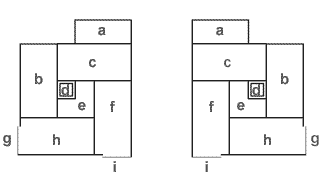|
||
 |
||
In a 4 1/2 mat tea ceremony room in the normal position hongatte {θ, the alcove is on the right at the back of the room. The mat for a high ranking guest *kinindatami Mlτ, is at the front of the alcove. In the front wall near the guest mat *kyakudatami qτ, is a small crawl-in or wiggle-in entrance. It has an entrance mat called a *fumikomidatami ₯τ. This tea ceremony room should also have a utensil mat *dougudatami Ήοτ, which will sometimes double as the host's mat *temaedatami _Oτ.
These mat positions are only used in the fall and winter when a sunken firebox is used. In the spring the firebox is covered and a portable stove *furo F, is used to heat water. The kinindatami and dougudatami remain as they are, but the two guests mats are placed in front of the kinindatami. The half size mat is set in front of the host's entrance *sadouguchi Ήϋ, and is called a step-in mat. The *gyakugatte tθ method exactly reverses these normal positions.
The yojouhan tea ceremony room is attributed to Murata Jukou Ίcμυ (1422-1502) and became a formal type tea ceremony room during the time of Takeno Jouou μΠ¨ (1504-55). It became the dominant tea ceremony room during the time of Sen Rikyuuηx (1522-91).
| @ | |||||||||||
|
|||||||||||
@
 a) *toko °@b) *temaedatami _Oτ@c) *kinindatami Mlτ d) *ro F@e) *rodatami Fτ@f) *kyakudatami qτ g) *sadouguchi Ήϋ@h) *fumikomidatami ₯τ@ i) *nijiriguchi ηWϋ |
@
(C)2001 Japanese Architecture and Art Net Users System.@No reproduction or republication without written permission.
fΪΜeLXgEΚ^ECXgΘΗASΔΜRecΜ³f‘»E]ΪπΦΆά·B

